Chiayi County is blessed with several worthwhile upland trails, not all of which I’ve hiked. A few weeks ago, I finally got around to tackling Tanghu Historic Trail (塘湖古道), a short but unusually steep route in Jhuci Township (竹崎).
According to the Web site of the Alishan National Scenic Area (阿里山國家風景區), the path climbs from 308m above sea level to an elevation of 770m in just 1.58km, an average gradient of 29 percent. And unless you arrange for someone to bring you to the starting point and collect you at the other end, there’s no way to avoid a significant amount of additional uphill walking.
TANGHU
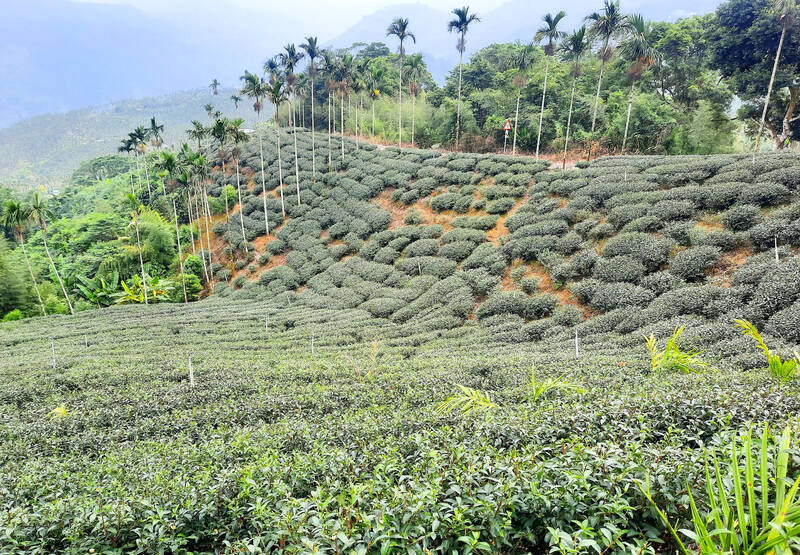
Photo: Steven Crook
Like many of Taiwan’s old trails, the path that connects the lowlands with the secluded settlement of Tanghu (塘湖) was originally established by Han pioneers who needed to transport essentials up to their farmsteads and carry crops and forest commodities down to market.
Some hikers park at the trail’s western trailhead, plod upward to the eastern entrance, then retrace their steps. That didn’t appeal to me, so instead I planned out a whole-day thru-hike that’d bring me to a few other points of interest once I’d got Tanghu Historic Trail under my belt.
Doing things that way meant I first had to march along Chiayi Local Road 120 (嘉120). After refilling my water bottles at a temple — and declining an invitation to join a retirees’ karaoke session — I crossed Singyun Bridge (行運橋). On the other side, there’s a small parking lot and a bilingual information board that tells you the basics.
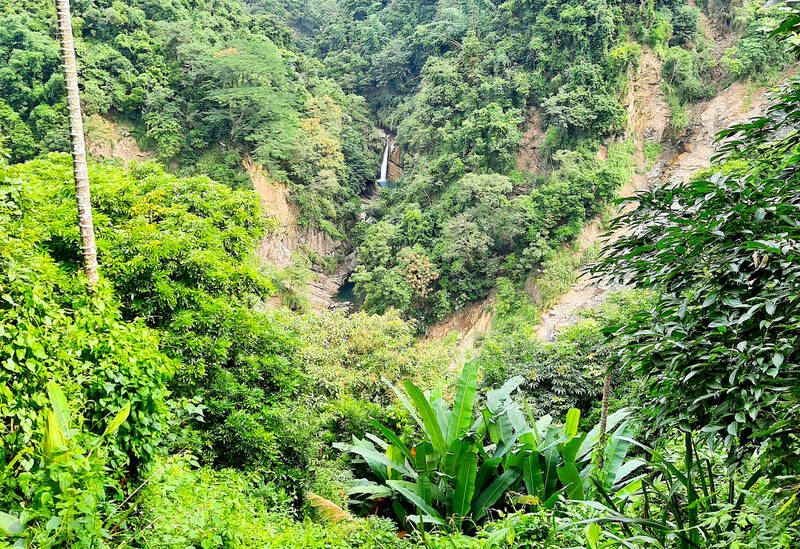
Photo: Steven Crook
The trail starts at the far end of the parking lot, close to the creek. The first stretch is flat and, on the day I was there, a little slippery. The rest of the historic trail is quite different: Steps, steps and more steps, but well maintained. There’s a distance marker every 100m, and two spots where you can sit down and take a proper rest.
At the first, a wooden platform 700m from the western trailhead, it’s possible to see Wenggangtan Waterfall (甕缸潭瀑布). If you enjoy clearer weather than I had, the view over the plains from the second rest area might well be excellent.
I’d not been hiking more than 10 minutes when a large snake slithered off the trail and into the undergrowth. I expected macaques and saw half a dozen. Holding onto the railing to steady myself was never an option; every time I looked at it, countless ants were using it as a two-way superhighway. To my surprise, I didn’t encounter a single mosquito.

Photo: Steven Crook
The screech of at least one Crested serpent eagle was occasionally accompanied by manmade noise, as a locomotive on the Alishan Forest Railway slowly chugged up nearby Dulishan (獨立山).
An hour and a quarter after I’d started climbing Tanghu Historic Trail, I was standing at the eastern trailhead, trying to figure out which of the two concrete tracks I should follow to proceed onward to Road 166. An online map hinted that the one on the right might be the correct choice. It was, and it soon broadened from something only highly adventurous motorcyclists would try to ride on to the kind of farmers’ road that’s common in mid-elevation mountains.
The first house I saw had obviously been abandoned years earlier, but it turns out that some people still live in Tanghu. The walk to Road 166 (distance 2.5km) seemed almost flat after coming up the historic trail, but by the time I reached Road 166, I was almost 900m above sea level.
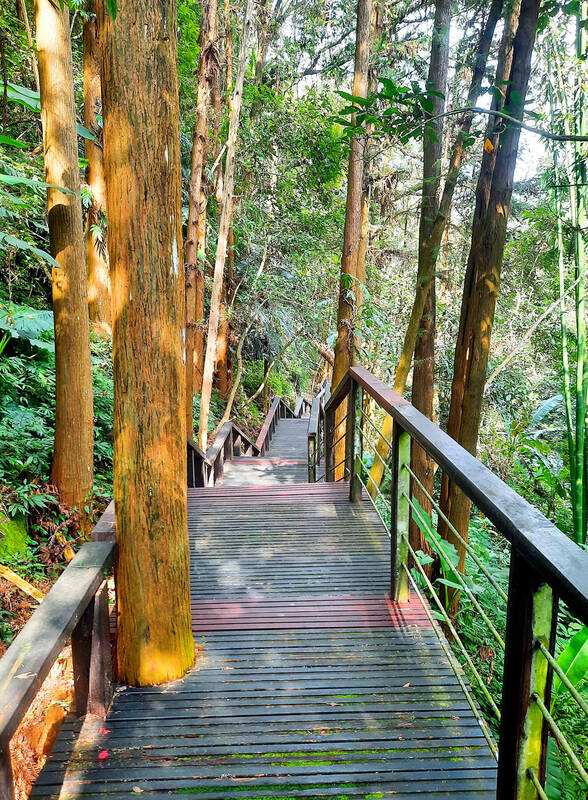
Photo: Steven Crook
Turning left, I reminded myself to keep my ears open for approaching vehicles. On narrow mountain roads, not every driver can be depended on to leave space for walkers. Soon I was at the intersection of Road 166 and Chiayi Local Road 154 (嘉154), where a sharp left took me past several tea plantations and then, via an unnumbered shortcut, close to Liyuanliao (梨園寮), a station on the Alishan Railway.
By the time I was back on Local Road 154, I was starting to feel weary, and the tea-and-betel-nut scenery was getting repetitive. Soon enough, I came across a little shop with a bench. The selection of liquids was limited, but at least they were cold. After an isotonic sports drink, sipped slowly with my shoes off, I was ready to resume tramping.
IMMORTAL HOLES TRAIL
Less than 1km before Local Road 154 merges with Road 162A (162甲), there are parking spots for five cars and the eastern entrance of the Immortal Holes Trail (仙人堀杉林步道). The trail is a mere 430m in length, and the two “attractions” it provides access to fall far short of being overwhelming. Yet it’s a true delight, there being forest on one side of the boardwalk and a charming little creek on the other.
After taking a quick look at Jade Conch Cave (玉螺洞) and the Immortal’s Footprint (仙腳印) — both features were created by water erosion — I lingered on the trail for a good while. If I didn’t need to catch a bus at Taiping (太平), I’d probably have stayed a bit longer.
Fewer than 500 people live in Taiping, and many of those who don’t make a living by cultivating tea or orchids are involved in tourism. Taiping Old Street (太平老街) isn’t especially characterful, but it’s been getting more visitors since the opening a few years ago of Taiping Suspension Bridge (太平雲梯, literally “Taiping Ladder”).
The English name of this structure doesn’t do it proper justice. Unlike the short steel-wire-and-wooden-plank footbridges that span creeks and ravines throughout Taiwan, this 281m-long landmark doesn’t exist to provide access to anywhere in particular. Instead, it serves as a platform from which sightseers can, depending on conditions, enjoy a “sea of clouds” or impressive views over the flatter landscapes to the west. Regular tickets cost NT$100; students, children under the age of 11, and senior citizens qualify for discounts.
The road between Taiping and Meishan (梅山) is famously twisting, and the bus I boarded hurtled downhill a good bit faster than I’d have preferred. Walking may be pretty slow, but at least you don’t feel like you’ve placed your life in someone else’s hands.
Steven Crook has been writing about travel, culture and business in Taiwan since 1996. He is the author of Taiwan: The Bradt Travel Guide and co-author of A Culinary History of Taipei: Beyond Pork and Ponlai.
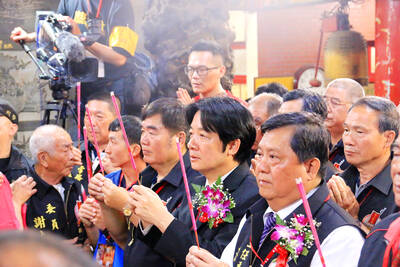
The Democratic Progressive Party (DPP), Chinese Nationalist Party (KMT), and the country’s other political groups dare not offend religious groups, says Chen Lih-ming (陳立民), founder of the Taiwan Anti-Religion Alliance (台灣反宗教者聯盟). “It’s the same in other democracies, of course, but because political struggles in Taiwan are extraordinarily fierce, you’ll see candidates visiting several temples each day ahead of elections. That adds impetus to religion here,” says the retired college lecturer. In Japan’s most recent election, the Liberal Democratic Party lost many votes because of its ties to the Unification Church (“the Moonies”). Chen contrasts the progress made by anti-religion movements in
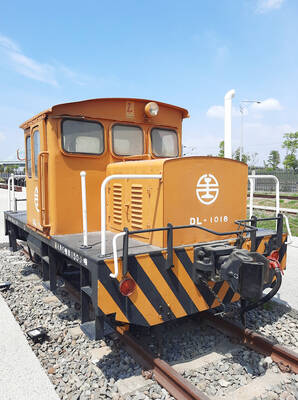
Taiwan doesn’t have a lot of railways, but its network has plenty of history. The government-owned entity that last year became the Taiwan Railway Corp (TRC) has been operating trains since 1891. During the 1895-1945 period of Japanese rule, the colonial government made huge investments in rail infrastructure. The northern port city of Keelung was connected to Kaohsiung in the south. New lines appeared in Pingtung, Yilan and the Hualien-Taitung region. Railway enthusiasts exploring Taiwan will find plenty to amuse themselves. Taipei will soon gain its second rail-themed museum. Elsewhere there’s a number of endearing branch lines and rolling-stock collections, some

Last week the State Department made several small changes to its Web information on Taiwan. First, it removed a statement saying that the US “does not support Taiwan independence.” The current statement now reads: “We oppose any unilateral changes to the status quo from either side. We expect cross-strait differences to be resolved by peaceful means, free from coercion, in a manner acceptable to the people on both sides of the Strait.” In 2022 the administration of Joe Biden also removed that verbiage, but after a month of pressure from the People’s Republic of China (PRC), reinstated it. The American

Chinese Nationalist Party (KMT) legislative caucus convener Fu Kun-chi (傅?萁) and some in the deep blue camp seem determined to ensure many of the recall campaigns against their lawmakers succeed. Widely known as the “King of Hualien,” Fu also appears to have become the king of the KMT. In theory, Legislative Speaker Han Kuo-yu (韓國瑜) outranks him, but Han is supposed to be even-handed in negotiations between party caucuses — the Democratic Progressive Party (DPP) says he is not — and Fu has been outright ignoring Han. Party Chairman Eric Chu (朱立倫) isn’t taking the lead on anything while Fu